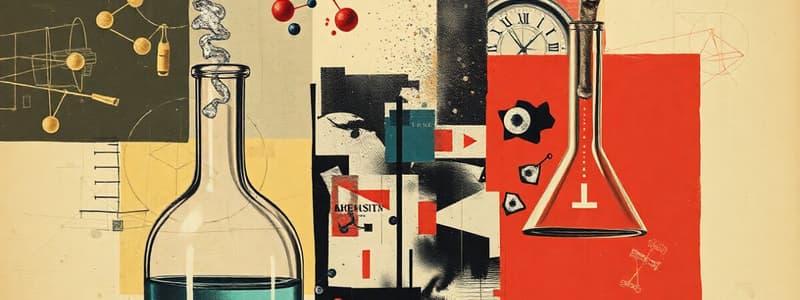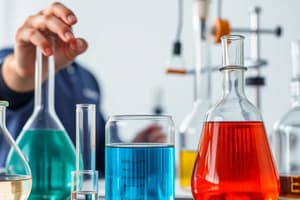Podcast
Questions and Answers
A student measures the length of a table using a meter stick. The measurement is recorded as 1.450 meters. How many significant figures are in this measurement?
A student measures the length of a table using a meter stick. The measurement is recorded as 1.450 meters. How many significant figures are in this measurement?
- 3
- 4 (correct)
- 2
- 5
Which of the following measurements has the most number of significant figures?
Which of the following measurements has the most number of significant figures?
- 4.50 x $10^3$ m (correct)
- 405 m
- 450 m
- 0.0045 m
A car travels 25 miles in 30 minutes. What conversion factor would you use to find the speed in kilometers per hour (km/h)? Given: 1 mile = 1.609 kilometers.
A car travels 25 miles in 30 minutes. What conversion factor would you use to find the speed in kilometers per hour (km/h)? Given: 1 mile = 1.609 kilometers.
- $\frac{25 \text{ miles}}{30 \text{ minutes}} \cdot \frac{1.609 \text{ kilometers}}{1 \text{ mile}} \cdot \frac{60 \text{ minutes}}{1 \text{ hour}}$ (correct)
- $\frac{30 \text{ minutes}}{25 \text{ miles}} \cdot \frac{1.609 \text{ kilometers}}{1 \text{ mile}} \cdot \frac{1 \text{ hour}}{60 \text{ minutes}}$
- $\frac{25 \text{ miles}}{30 \text{ minutes}} \cdot \frac{1 \text{ mile}}{1.609 \text{ kilometers}} \cdot \frac{1 \text{ hour}}{60 \text{ minutes}}$
- $\frac{30 \text{ minutes}}{25 \text{ miles}} \cdot \frac{1 \text{ mile}}{1.609 \text{ kilometers}} \cdot \frac{60 \text{ minutes}}{1 \text{ hour}}$
The area of a rectangular room is found by multiplying its length and width. If the length is measured to be 12.55 meters and the width is measured to be 8.25 meters, what is the area of the room, expressed with the correct number of significant figures?
The area of a rectangular room is found by multiplying its length and width. If the length is measured to be 12.55 meters and the width is measured to be 8.25 meters, what is the area of the room, expressed with the correct number of significant figures?
A scientist measures a very small distance to be 0.00000000275 meters. How is this number expressed in scientific notation with the correct number of significant figures?
A scientist measures a very small distance to be 0.00000000275 meters. How is this number expressed in scientific notation with the correct number of significant figures?
A researcher observes a new phenomenon and proposes a possible explanation. What is the next step in the scientific method?
A researcher observes a new phenomenon and proposes a possible explanation. What is the next step in the scientific method?
Which of the following best describes the relationship between a hypothesis, a theory, and a scientific law?
Which of the following best describes the relationship between a hypothesis, a theory, and a scientific law?
A student measures the temperature of a solution and records it as 25.0°C. To convert this temperature to Kelvin, the student should:
A student measures the temperature of a solution and records it as 25.0°C. To convert this temperature to Kelvin, the student should:
Density is a derived unit. Which of the following pairs of SI units are used to express density?
Density is a derived unit. Which of the following pairs of SI units are used to express density?
A chemist performs three separate experiments to measure the melting point of a substance. The measurements are 145.2°C, 145.1°C, and 145.3°C. The actual melting point is known to be 150.0°C. Which statement best describes the chemist's measurements?
A chemist performs three separate experiments to measure the melting point of a substance. The measurements are 145.2°C, 145.1°C, and 145.3°C. The actual melting point is known to be 150.0°C. Which statement best describes the chemist's measurements?
A student measures the volume of a liquid using a graduated cylinder. The meniscus is exactly on the 25 mL mark. How should the student report the measurement with appropriate significant figures, assuming the graduated cylinder has markings every 1mL?
A student measures the volume of a liquid using a graduated cylinder. The meniscus is exactly on the 25 mL mark. How should the student report the measurement with appropriate significant figures, assuming the graduated cylinder has markings every 1mL?
Which of the following is NOT a characteristic property used to describe matter?
Which of the following is NOT a characteristic property used to describe matter?
Why is chemistry considered a central science?
Why is chemistry considered a central science?
Flashcards
Significant Figures
Significant Figures
Digits in a measurement that carry meaning contributing to its precision.
Which digits are significant?
Which digits are significant?
All non-zero numbers, zeros between non-zeros, and trailing zeros after a decimal
Scientific Notation
Scientific Notation
Expressing numbers as a coefficient (1-10) times a power of 10.
Dimensional Analysis
Dimensional Analysis
Signup and view all the flashcards
Conversion Factor
Conversion Factor
Signup and view all the flashcards
What is Chemistry?
What is Chemistry?
Signup and view all the flashcards
What is Matter?
What is Matter?
Signup and view all the flashcards
What is a Property?
What is a Property?
Signup and view all the flashcards
What is a Hypothesis?
What is a Hypothesis?
Signup and view all the flashcards
What is a Scientific Law?
What is a Scientific Law?
Signup and view all the flashcards
What is the SI system?
What is the SI system?
Signup and view all the flashcards
What is Volume?
What is Volume?
Signup and view all the flashcards
What is Density?
What is Density?
Signup and view all the flashcards
Study Notes
- Chemistry examines matter, its properties, and its transformations.
- Matter possesses mass and occupies space.
- Properties like color, density, and flammability characterize matter.
- Chemistry facilitates an understanding of our surroundings.
- Chemistry aids the development of new products and technologies.
- Chemistry helps address challenges in medicine, agriculture, and environmental science.
- The scientific method is a systematic approach to acquiring knowledge.
- The scientific method starts with observation and forms a hypothesis.
- A hypothesis provides a testable explanation for an observation.
- Hypotheses are tested through experimentation.
- Experiments yield data.
- Data analysis determines if the hypothesis is supported or refuted.
- A supported hypothesis may become accepted as a theory.
- A scientific law describes a natural phenomenon that consistently holds true.
- Chemistry relies on quantitative measurements.
- Measurements use various units.
- The SI system is the standard set of units in science.
- SI units include meter (m) for length, kilogram (kg) for mass, second (s) for time, kelvin (K) for temperature, and mole (mol) for substance amount.
- A derived unit is defined using other units.
- Volume, a derived unit, measures the space a substance occupies.
- Density, a derived unit, is the mass per unit volume.
- Temperature reflects the average kinetic energy of atoms/molecules.
- Celsius, Fahrenheit, and Kelvin are three common temperature scales.
- The Celsius scale uses water's freezing and boiling points as references.
- The Fahrenheit scale uses the freezing and boiling points of a salt solution as references.
- The Kelvin scale is an absolute temperature scale, starting at absolute zero.
- Absolute zero represents the lowest possible temperature.
- The relationship between Kelvin and Celsius is: K = °C + 273.15.
- Measurement uncertainty indicates inaccuracy or imprecision.
- Accuracy reflects how close a measurement is to the true value.
- Precision indicates the closeness of repeated measurements.
- Significant figures include certain digits plus one uncertain digit.
- Significant figures depend on the measuring instrument's precision.
Rules for Significant Figures:
- All non-zero digits are significant.
- Zeros between non-zero digits are significant.
- Leading zeros are not significant.
- Trailing zeros after the decimal point are significant.
- Trailing zeros in whole numbers without a decimal point are not significant.
- Scientific notation expresses very large or small numbers.
- A number in scientific notation is written as coefficient x 10exponent.
- The coefficient is between 1 and 10.
- The exponent is an integer.
- Dimensional analysis converts between units.
- Dimensional analysis uses conversion factors to change units.
- A conversion factor is a ratio equal to 1.
- Units in the conversion factor cancel, resulting in the desired units.
Studying That Suits You
Use AI to generate personalized quizzes and flashcards to suit your learning preferences.




